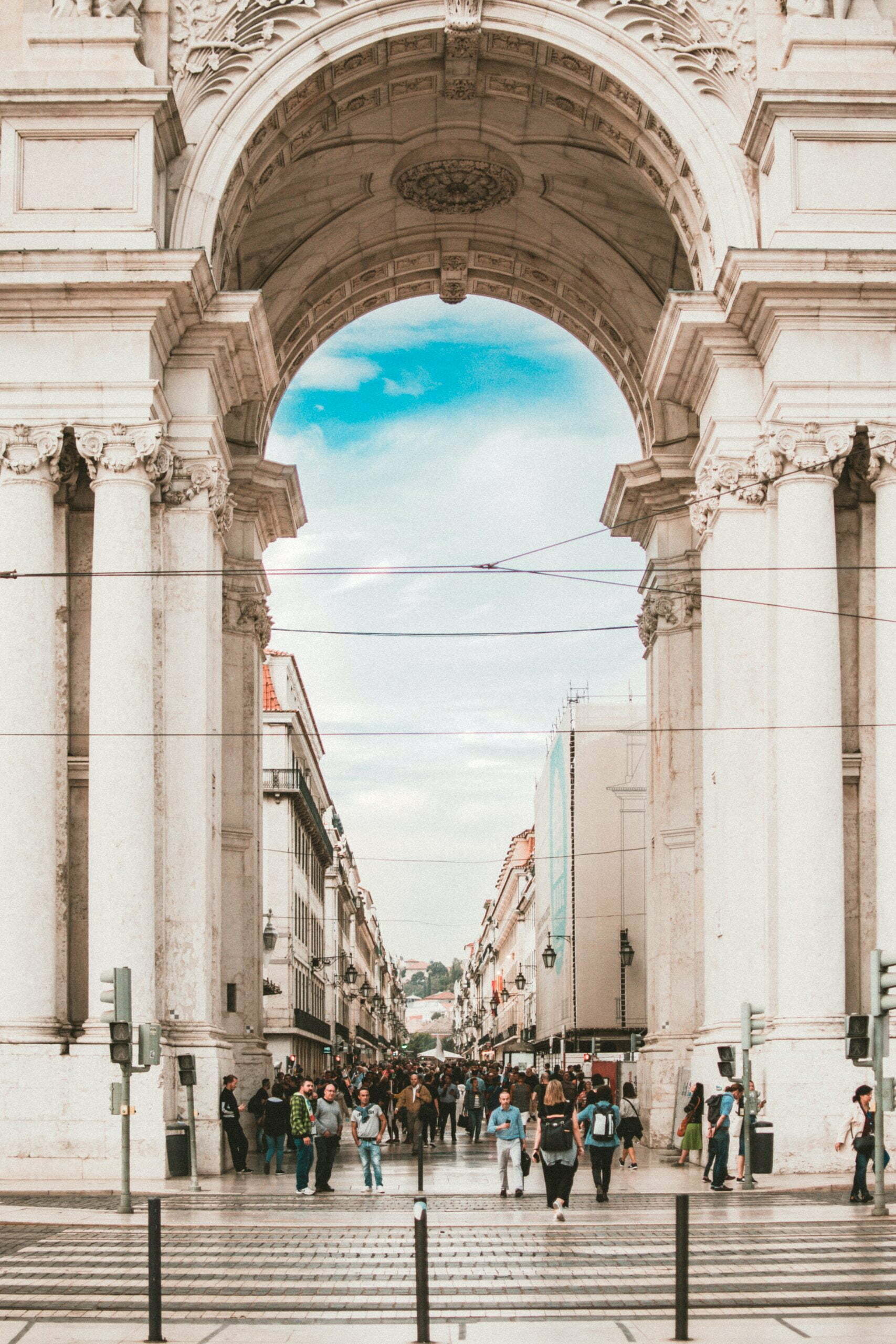Thanks to its many charms, Lisbon has been a city on the radar of many travelers for years. The Portuguese capital has so much to offer, from its stunning architecture, winding streets, and delicious food. Once you experience this enchanting city for yourself, it’s not hard to see why it is so loved.
Chances are you have many questions about Lisbon or hope to learn more about this beautiful place before your trip. In this article, we’ll explore all things Lisbon, such as how did Lisbon get its name? Where is Lisbon in Portugal? So, let’s take a closer look at this gorgeous city, shall we?
Where is Lisbon in Portugal?
Lisbon is located on the country’s western coast, on the River Tagus and the Atlantic Ocean. The city has seven hills, which adds to the charm of Lisbon and can make for some stunning views.
Lisbon is not only Portugal’s largest city, but its location also makes it its main port. Known as Europe’s westernmost capital city, Lisbon is also a great starting point for exploring Portugal. With cities such as Sintra and Porto only a car journey away, you can easily add them to your itinerary.

How Did Lisbon Get Its Name?
Although there is no clear evidence on who discovered Lisbon or how it got its name, this doesn’t stop the theories from rolling in! The first, and most fun theory, derives from Greek mythology.
Lisbon was once known as Olisipo, which was said to have been named after the city’s founder. According to legend, Ulysses, also known as Odysseus, was the one who founded the city of Lisbon after returning home from his 10-year journey from Troy.
The second theory is that Olisipo comes from the Phoenician word ‘Alis Ubbo,’ which means ‘delightful little port’ or ‘pleasant haven.’ This is likely because the city’s harbor and river frontage made it a perfect spot for a trading port. It wasn’t until the city was under Moorish rule in the 8th century that the first variations of ‘Lisbon’ emerged.

The History of Lisbon Portugal
Lisbon does not disappoint when it comes to history, and there is a rich culture to be explored at every turn. When you visit Portugal you probably will fly into Lisbon. Therefore, it will benefit you if you know a narrative of the surrounding city.
Early History: The Roman Empire to Moorish Rule
As we know, there is no evidence on who discovered Lisbon; however, if we look at the history, we can piece together a pretty good timeline. There’s a good chance the first settlers of Lisbon were the Phoenicians, who would have arrived around 1200 BC.
In 205 BC, the city was taken over by the Romans. Later Julius Caesar renamed the city Felicitas Julia. Even now, in modern-day Lisbon, evidence of the Roman occupation is seen across the city, which has to be one reason Lisbon draws in so many visitors.
After the Romans, the city changed hands several times. From the Alani people to various Germanic tribes, including Suebi and then the Visigoths in the 5th century, Lisbon was prone to many invaders due to its prime location.
During the 8th century, the Moors conquered the city and stayed in power for over 400 years. During this time, Lisbon flourished, and the Moorish influence is still seen today in some of the city’s architecture.
Portuguese Rule
In 1147, Afonso I’s army conquered the city. Afonso I, was also known as Afonso Henriques, the first king of Portugal. It was during this reign that marked the beginning of Portuguese rule.
Various landmarks we see today were created during this time, such as the Lisbon Cathedral, which was said to have first been a Moorish Mosque. The city also became an important educational center, with the country’s first university being founded there between 1288 and 1290 by King Dinis I.
Even when faced with many tragedies, such as earthquakes, fires, and attacks from Castilian forces, Lisbon remained an important city within Portugal and across Europe.

Age of Discovery
The Age of Discovery, also known as the Age of Exploration, is a period in history spanning the 15th and 16th centuries. During this time, Europeans started to venture out and explore the world, and Lisbon played a significant role.
Many famous voyages set sail from Lisbon, and they also welcomed various colonies from countries such as France and Germany. These voyages not only helped Europeans to better understand the world around them but also had a considerable impact on the economy, as establishing new trade routes occurred.
Under the rule of King Manuel I, it was during this time that Portugal had a big hand in architectural design across Europe, which included the late gothic Manueline style. The style can still be seen in some of Lisbon’s most iconic buildings, such as the Jeronimos Monastery.
Rebuilt From Ruins
In 1755, Lisbon fell victim to a devastating earthquake, which ultimately destroyed much of the city. The tragedy was then followed by a tsunami and a fire, almost destroying everything that remained.
Despite this, the city was rebuilt and continued to play an essential role as the capital of Portugal.
Until it wasn’t.
Following the Napoleon invasion, Lisbon lost the title of capital to Rio de Janeiro. The royal family relocated to Rio de Janeiro during the Peninsular War. It was not until 1821 that Lisbon regained its status as the capital.
In the years following, the city continued to become a thrive as one of Europe’s most popular tourist destinations!

Why is Lisbon the Best City to Visit in Europe?
People flock to this Portuguese City, and many claim it is the best city in Europe. However, why is Lisbon the best city to visit in Europe?
Well, for starters, Lisbon is an incredibly diverse city. It has something for everyone, whether you’re interested in history and culture or want to enjoy the food and wine. Plus, let’s not forget that it’s also a very affordable city, making it the perfect destination for budget travelers.
But perhaps the biggest reason why it is the best city to visit in Europe is its people. The locals are known for being incredibly friendly and welcoming, and they’re very accepting of tourists.
Here are some of my favorite things to do in Lisbon:
Visit the Castle of Sao Jorge
Explore the Belem district
Ride on the Santa Justa Elevator
Visit the Lisbon Cathedral
Wander through the streets of the Alfama district
Enjoy views of the city from Parque Eduardo VII
Check out the Museu do Teatro Romano (for Roman ruins!)
Atypical Last Thoughts
Portugal is a fantastic country to visit with a rich history with a base in exploration. When you visit Portugal you must visit Porto and Lisbon.
Lisbon is a city with an extensive history and varied culture. Which you can observe in the city’s many iconic landmarks. From the castles and cathedrals to its museums and parks, and its friendly locals and affordable prices, it’s no wonder Lisbon is seen as the best city to visit in Europe!
If becoming a digital nomad like me sounds like something you might be interested in, be sure to check out my great range of resources on the subject.




[…] addition to traditional accommodations, Lisbon offers unique and alternative options for adventurous travelers. Consider staying in a hostel for a […]
[…] The older neighborhoods have increased frequencies of graffiti and damage to the sidewalks. Part of the reason is that this has higher frequencies of people. Students live in these areas, and tourists enjoy the cheaper accommodations. However, the graffiti isn’t nearly as prevalent as in Lisbon. […]